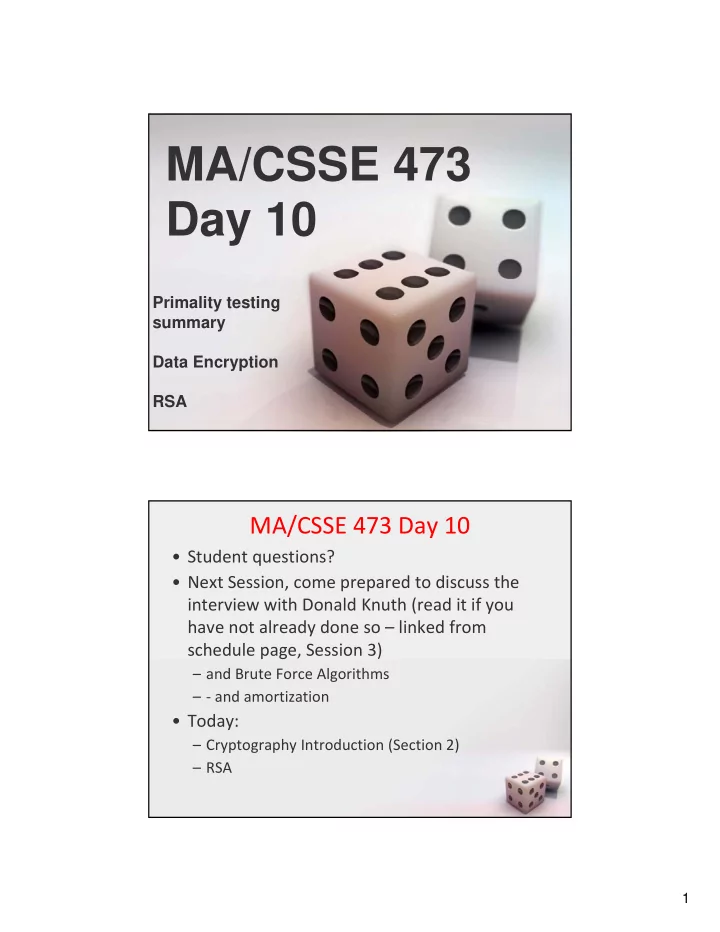

MA/CSSE 473 Day 10 Primality testing summary Data Encryption RSA MA/CSSE 473 Day 10 • Student questions? • Next Session, come prepared to discuss the interview with Donald Knuth (read it if you have not already done so – linked from schedule page, Session 3) – and Brute Force Algorithms – ‐ and amortization • Today: – Cryptography Introduction (Section 2) – RSA 1
We'll only scratch the surface, but there is MA/CSSE 479 CRYPTOGRAPHY INTRODUCTION Cryptography Scenario • I want to transmit a message m to you – in a form e ( m ) that you can readily decode by running d ( e ( m )), – And that an eavesdropper has little chance of decoding • Private ‐ key protocols – You and I meet beforehand and agree on e and d. • Public ‐ key protocols – You publish an e for which you know the d, but it is very difficult for someone else to guess the d. – Then I can use e to encode messages that only you* can decode * and anyone else who can figure out what d is if they know e. 2
Messages can be integers • Since a message is a sequence of bits … • We can consider the message to be a sequence of b ‐ bit integers (where b is fairly large), and encode each of those integers. • Here we focus on encoding and decoding a single integer. RSA Public ‐ key Cryptography • Rivest ‐ Shamir ‐ Adleman (1977) – A reference : Mark Weiss, Data Structures and Problem Solving Using Java, Section 7.4 • Consider a message to be a number modulo N, an k ‐ bit number (longer messages can be broken up into k ‐ bit pieces) • The encryption function will be a bijection on {0, 1, …, N ‐ 1}, and the decryption function will be its inverse • How to pick the N and the bijection? bijection: a function f from a set X to a set Y with the property that for every y in Y, there is exactly one x in X such that f(x) = y. In other words, f is both one-to-one and onto. 3
N = p q • Pick two large primes, p and q, and let N = pq. • Property : If e is any number that is relatively prime to N' = (p ‐ 1)(q ‐ 1), then – the mapping x x e mod N is a bijection on {0, 1, …, N ‐ 1} – If d is the inverse of e mod (p ‐ 1)(q ‐ 1), then for all x in {0, 1, …, N ‐ 1}, (x e ) d x (mod N). • We'll first apply this property, then prove it. Q3 ‐ 4 Public and Private Keys • The first (bijection) property tells us that x x e mod N is a reasonable way to encode messages, since no information is lost – If you publish (N, e) as your public key , anyone can encrypt and send messages to you • The second tells how to decrypt a message – When you receive a message m', you can decode it by calculating (m') d mod N. 4
Example (from Wikipedia) • p=61, q=53. Compute N = pq = 3233 • (p ‐ 1)(q ‐ 1) = 60 ∙ 52 = 3120 • Choose e=17 (relatively prime to 3120) • Compute multiplicative inverse of 17 (mod 3120) – d = 2753 (evidence: 17 ∙ 2753 = 46801 = 1 + 15 ∙ 3120) • To encrypt m=123, take 123 17 (mod 3233) = 855 • To decrypt 855, take 855 2753 (mod 3233) = 123 • In practice, we would use much larger numbers for p and q. Q5 ‐ 6 Recap: RSA Public ‐ key Cryptography • Consider a message to be a number modulo N, n k ‐ bit number (longer messages can be broken up into n ‐ bit pieces) • Pick any two large primes, p and q, and let N = pq. • Property : If e is any number that is relatively prime to (p ‐ 1)(q ‐ 1), then – the mapping x x e mod N is a bijection on {0, 1, …, N ‐ 1} – If d is the inverse of e mod (p ‐ 1)(q ‐ 1), then for all x in {0, 1, …, N ‐ 1}, (x e ) d x (mod N). • We have applied the property, now we prove it 5
RSA security • Assumption (Factoring is hard!): – Given N, e, and x e mod N, it is computationally intractable to determine x – What would it take to determine x? • Presumably this will always be true if we choose N large enough • But people have found other ways to attack RSA, by gathering additional information • So these days, more sophisticated techniques are needed. • MA/CSSE 479 Student questions • On primality testing, RSA or anything else? 6
Recommend
More recommend